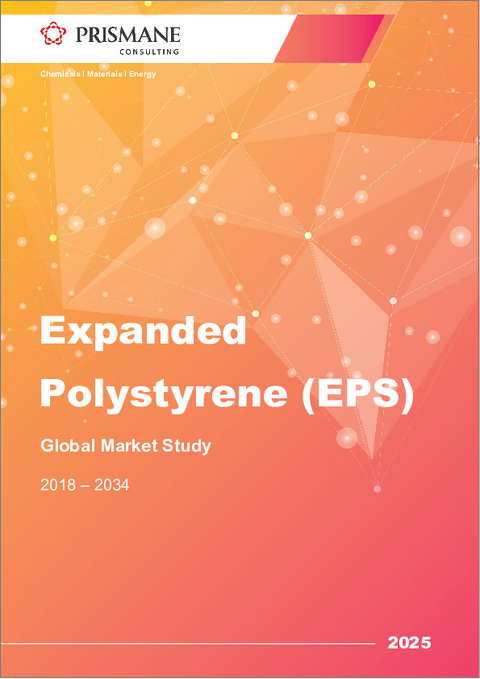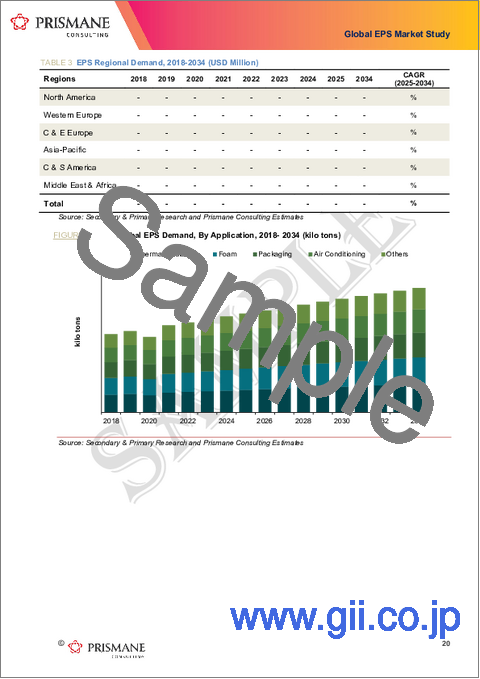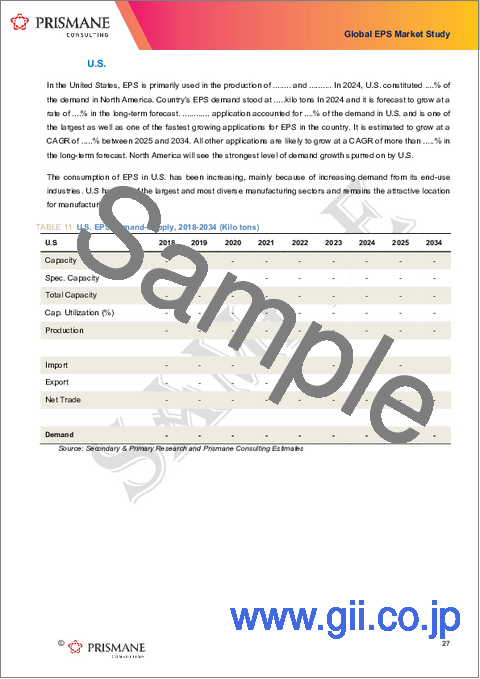|
|
市場調査レポート
商品コード
1771389
発泡スチロール(EPS)の世界市場の需要、予測分析(2018年~2034年)Global Expanded Polystyrene(EPS) Market Demand & Forecast Analysis, 2018-2034 |
||||||
|
|||||||
| 発泡スチロール(EPS)の世界市場の需要、予測分析(2018年~2034年) |
|
出版日: 2025年06月25日
発行: Prismane Consulting
ページ情報: 英文 111 Pages
納期: 3~5営業日
|
全表示
- 概要
- 目次
発泡スチロール(EPS)は、スチレンを原料とする製品の中でもっとも広く生産されており、スチレンの誘導体として2番目に大きいです。EPSは主にペンタンを使用した懸濁法で製造され、断熱材、包装、空調、フォーム製品などのさまざまな用途に使用されています。もっとも成長可能性があるのは、建設産業における断熱ボードへの需要です。その他のポリスチレンに比べ、EPSの価格は比較的安定している傾向があり、その変動はスチレン価格の動きと密接に結びついています。建設部門と包装部門を合わせると、EPS市場の総消費の80%超を占めています。
世界の需給の動向
2024年、世界のEPS生産能力は1万2,000キロトンを超え、2016年から700キロトン超の増加となっています。2032年までの見通しとしては、生産能力は主にアジアと中東・アフリカにおける拡張により、年平均100キロトン増加すると予測されます。中国が6,500キロトンを超える最大のEPS生産能力で市場を主導し、西欧がこれに続きます。
地域の需要の分析
アジア太平洋は依然としてEPSの最大の市場であり、世界消費の推定55~60%を占め、西欧がこれに続きます。この地域の主要国には、中国、日本、韓国、台湾が含まれます。中国だけでこの地域のEPS供給の約80%を消費し、世界のEPS需要の44%を占めています。中国の主な成長促進要因は、建設、包装、電気・電子部門で、これらを合わせると同国のEPS消費の90%超を占めます。消費者の購買力と生活水準が地域全体で向上し続けているため、EPS需要はさらに増加すると予測されます。
投資コストと経営コストの低下により、多くのメーカーが中国に製造プラントを設立するようになり、現在では世界のEPS生産能力の約45%を中国が占めています。中国の建設部門は近年減速していますが、包装用EPSへの需要の増加がこの落ち込みを補っています。新興市場における人口の増加と経済発展の進行により、EPS需要は増加基調を維持すると予測されます。全体として、世界のEPS市場は2032年にかけてCAGRで3~4%の成長を示すと予測されます。
EPS市場の近年の発展
2024年11月、Alpekは2025年1月までに同社のペンシルバニア州Monacaの施設でのEPS生産を停止する計画を発表しました。これにより、同社のEPS生産能力は世界全体で約500キロトンから123キロトン減少することになります。2022年、Epsilyteはイリノイの施設での生産を11キロトン拡大する計画を発表し、2023年末までに完了する予定です。同社はまた、最大100キロトンのさらなる拡張の可能性に向けた工学研究も開始しました。2022年12月、Supreme Petrochemはチェンナイにある同社のマナリプラントにおける生産能力のアップグレードを完了し、EPS生産高を24キロトンから33キロトンに増やしました。2022年3月、Supreme Petrochemはマハラシュトラ州ナゴタネの施設の拡張計画も発表し、2024年末までに生産能力を70キロトンから100キロトンに増強することを目指しています。完成すれば、同社のEPS生産能力は合計で約130キロトンに達する見込みです。
市場促進要因:建設産業からの需要の増加
EPS市場の主な促進要因の1つは、建設産業におけるエネルギー効率が高く費用対効果の高い断熱材への需要の高まりです。世界中で省エネに対する意識が高まり、建築規制が厳しくなる中、EPSは断熱に用いる信頼できるソリューションとして台頭してきました。EPSは施工が容易で、コストが低く、性能が長持ちするため、住宅と商業施設の両方の建設プロジェクトで好まれています。EPSの軽量な性質は輸送コストとカーボンフットプリントを削減し、その魅力をさらに高めています。新興経済国における都市化と可処分所得の増加も、EPS包装に依存する消費財、電子機器、家電の需要を推進しています。製造工程の進歩や、リサイクルへの取り組みなど持続可能性への関心の高まりも、多用途で環境にやさしい材料としてのEPSの採用を後押ししています。これらの要因が相まって、EPSの世界市場の着実な成長を後押ししています。
当レポートでは、世界の発泡スチロール(EPS)市場について調査分析し、市場力学と産業動向、各セグメントの需給、メーカーのプロファイルなどの情報を提供しています。
目次
第1章 イントロダクション
第2章 市場の要約
- 市場の進化
- 需給の概要
- 産業構造
- 戦略上の問題
- 最終用途の動向
- 成長予測
第3章 経済とエネルギーの見通し
- GDPと人口動態
- 金融政策と財政政策
- 原油生産と価格
- 天然ガス
- 電気料金
第4章 最終用途部門の業績
- 包装
- 工業
- 電気・電子
- 自動車
- 建設
- その他
第5章 生産能力(プラントとプロジェクト)の分析
- 生産能力:企業別
- 生産能力:国/地域別
- 生産能力の概要:地域/国別
第6章 発泡スチロール(EPS)のイントロダクションと市場の概要
- 製品の説明
- グレードと特性
- 原材料
- 製造プロセス
- 環境問題
- バリューチェーン
- 用途
第7章 市場力学と産業動向
- 市場力学
- 促進要因
- 抑制要因
- 機会
- 課題
第8章 世界の発泡スチロール(EPS)の需給の分析:用途別(数量と金額)(2018年~2034年)
- 戦略上の問題
- 需給の分析と予測(2018年~2034年)
- 生産能力
- 稼働率
- 生産
- 輸入
- 輸出
- 純輸出
- 需要
- 需要成長率
- 促進要因の分析
- 世界の発泡スチロール(EPS)市場:用途別
- 断熱
- フォーム
- 包装
- 空調
- その他
第9章 需給の分析と市場のレビュー:地域/国別(数量と金額)(2018年~2034年)
- 戦略上の問題
- 生産能力
- 稼働率
- 生産
- 輸入
- 輸出
- 純輸出
- 需要
- 需要成長率
- 発泡スチロール(EPS)市場:用途別
- 北米
- 米国
- カナダ
- メキシコ
- 西欧
- ドイツ
- フランス
- イタリア
- 英国
- スペイン
- その他の西欧
- 中欧・東欧
- ロシア
- ポーランド
- その他の中欧・東欧
- アジア太平洋
- 中国
- 日本
- インド
- 韓国
- その他のアジア太平洋
- 中南米
- 中東・アフリカ
第10章 価格分析
- 発泡スチロール(EPS)の平均価格、米ドル/kg
- 平均価格:地域別
- 価格の予測
第11章 主な戦略上の問題
第12章 機会の評価
- 市場の魅力の評価
- 見通しとターゲット市場の調査
第13章 戦略的推奨と提案
第14章 企業分析
- 発泡スチロール(EPS)メーカーのプロファイル/企業分析
- 基本詳細
- 本社、主要市場
- 所有
- 企業の財務
- 製造拠点
- 世界の売上
- 総従業員数
- 製品ポートフォリオ/サービス/ソリューション
- 採用された主な事業戦略とPrismane Consultingの概要
- 近年の発展
- 対象企業
- ACH Foam Technologies
- Alpek SAB de CV
- BASF
- Kaneka Corporation
- SIBUR Holding
- SABIC
- SUNPOR KUNSTSTOFF GmbH
- Synbra Holding bv
- Synthos S.A
- Total S.A
- その他のメーカー
第15章 付録
Expanded Polystyrene (EPS) is the most widely produced styrene-based products, ranking as the second-largest derivative of styrene. It is manufactured primarily through the suspension process using pentane, EPS is used in various applications including thermal insulation, packaging, air conditioning, and foam products. The strongest growth potential lies in the demand for thermal insulation boards in the construction industry. Compared to other forms of polystyrene, EPS prices tend to remain relatively stable, with fluctuations closely tied to styrene price movements. Combined, the construction and packaging sectors contribute to over 80% of total EPS market consumption.
Global Demand and Supply Trends
In 2024, global EPS production capacity exceeded more than 12,000 kilotons, representing an increase of over 700 kilotons since 2016. Looking ahead to 2032, capacity is projected to grow by an average of 100 kilotons annually, driven primarily by expansions in Asia and the Middle East & Africa. China leads the market with the largest EPS production capacity, surpassing 6,500 kilotons, followed by Western Europe.
Global EPS demand was estimated at around 8,200 kilotons in 2021, growing at an average annual rate of 2% over the previous five years. This growth has been largely driven by increasing demand from the construction, packaging, and consumer goods sectors. The market is expected to expand at a faster pace, with a projected average annual growth rate of 3.5% through 2032.
The construction industry accounts for more than 55% of global EPS demand, owing to the material's excellent insulation properties, lightweight structure, and durability. EPS is widely used in building walls, roofs, and cold storage facilities, playing a crucial role in improving the thermal efficiency and structural performance of buildings. In the packaging sector, EPS is highly valued for its shock-absorbing and insulating qualities. It is extensively used to protect home appliances, medical equipment, food and beverages, electronics, and other fragile items during transportation. In 2021, global EPS demand for packaging applications was estimated at approximately 2,000 kilotons and is expected to exceed 2,750 kilotons by 2032, growing at a compound annual growth rate (CAGR) of 4%.
Besides construction and packaging, EPS is also utilized in industrial applications such as molding, prototyping, and display products. The electrical and electronics industry benefits from EPS's superior insulation properties, while the automotive sector uses EPS to produce lightweight components that improve fuel efficiency. Overall, the construction industry remains the largest and most vital end-use segment, particularly for residential and commercial insulation projects where energy conservation is a top priority.
Regional Demand Analysis
The Asia-Pacific region remains the largest market for EPS, accounting for an estimated 55-60% of global consumption, followed by Western Europe. Key countries in this region include China, Japan, South Korea, and Taiwan. China alone consumes around 80% of the regional EPS supply and represents 44% of global EPS demand. The primary growth drivers in China are the construction, packaging, and electrical and electronics sectors, which together account for more than 90% of the country's EPS consumption. As consumer purchasing power and living standards continue to improve across the region, EPS demand is expected to rise further.
Lower investment and operational costs have encouraged many producers to establish manufacturing plants in China, which now holds approximately 45% of the world's EPS production capacity. Although China's construction sector has recently slowed, rising demand for EPS in packaging has helped offset this decline. With growing populations and ongoing economic development in emerging markets, EPS demand is expected to maintain its upward trajectory. Overall, the global EPS market is projected to grow at a compound annual growth rate (CAGR) of 3-4% through 2032.
Key Manufacturers
Leading EPS producers in the Asia-Pacific region include LG Chemical, Korea Kumho Petrochemical Co Ltd (KKPC), SH Chemical Ltd, Supreme Petrochem, DIC Corporation, Toyo Styrene Co. Ltd, Kaneka Corp, Jiangsu Xinheqiao Chemical Co. Ltd, Jiangyin Nijiaxianj New Material, Loyal Group, Ming Dih Group, Taita Chemical, and Chi Mei. Prior to 2021, LG Polymers and Supreme Petrochem were the primary EPS producers in India. However, following a styrene gas leak incident in 2020, LG Polymers ceased operations, leaving Supreme Petrochem as the dominant EPS manufacturer in the country.
Recent Developments in the EPS Market
In November 2024, Alpek announced its plan to stop EPS production at its Monaca, Pennsylvania facility by January 2025. This move will reduce the company's overall EPS capacity by 123 kilo tons, from its global total of approximately 500 kilo tons. In 2022, Epsilyte declared plans to expand production at its Illinois facility by 11 kilo tons, with completion expected by the end of 2023. The company also initiated an engineering study for a potential further expansion of up to 100 kilo tons. In December 2022, Supreme Petrochem completed a capacity upgrade at its Manali plant in Chennai, increasing EPS output from 24 kilo tons to 33 kilo tons. In March 2022, Supreme Petrochem also announced a planned expansion of its Nagothane facility in Maharashtra, aiming to increase capacity from 70 kilo tons to 100 kilo tons by the end of 2024. Once completed, the company's total EPS capacity is expected to reach approximately 130 kilo tons.
Market Driver: Rising demand from the construction industry
One of the primary drivers for the EPS market is the increasing demand for energy-efficient and cost-effective insulation materials in the construction industry. With growing awareness around energy conservation and stringent building regulations across the globe, EPS has emerged as a reliable solution for thermal insulation. Its ease of installation, low cost, and long-lasting performance make it a preferred material in both residential and commercial construction projects. The lightweight nature of EPS reduces transportation costs and carbon footprint, further boosting its appeal. Urbanization and rising disposable incomes in emerging economies are also fueling the demand for consumer goods, electronics, and appliances that rely on EPS packaging. The advancements in manufacturing processes and increased focus on sustainability, including recycling initiatives, are supporting the adoption of EPS as a versatile and environmentally friendly material. Together, these factors are propelling steady growth in the global EPS market.
Table of Contents
1. Introduction
- Scope
- Market Coverage
- Applications
- Regions
- Countries
- Years Considered
- Historical - 2018 - 2023
- Base - 2024
- Forecast Period - 2025 - 2034
- Research Methodology
- Approach
- Research Methodology
- Prismane Consulting Market Models
- Assumptions & Limitations
- Abbreviations & Definitions
- Conversion Factors
- Data Sources
2. Market Synopsis
- Market Evolution
- Demand-Supply Overview
- Industry Structure
- Strategic Issues
- End-use Trends
- Growth Forecast
3. Economic & Energy Outlook
- GDP and Demographics
- Monetary & Fiscal Policies
- Crude Oil Production and prices
- Natural Gas
- Electricity Prices
4. End-use Sector Performance
- Packaging
- Industrial
- Electrical & Electronics
- Automotives
- Construction
- Others
5. Capacity (Plants & Projects) Analysis
- Capacity, by Company
- Capacity, by Country and by region
- Capacity Overview, By Region and Country
6. Introduction to Expanded Polystyrene (EPS) and Market Overview
- Product Description
- Grades & Properties
- Raw Material
- Manufacturing Process
- Environmental Issues
- Value Chain
- Applications
7. Market Dynamics and Industry Trends
- Market Dynamics
- Drivers
- Restraints
- Opportunities
- Challenges
8. Global Expanded Polystyrene (EPS) Demand-Supply Analysis, By Applications (Volume, Value) (2018-2034)
- Strategic Issues
- Demand-Supply Analysis and Forecast (2018- 2034)
- Capacity
- Capacity Utilization (%)
- Production
- Imports
- Exports
- Net Trade
- Demand
- Demand Growth Rate (%)
- Driving Force Analysis
- Global Expanded Polystyrene (EPS) Market, By Applications
- Thermal Insulation
- Foam
- Packaging
- Air Conditioning
- Others
9. Demand-Supply Analysis and Market Review, By Region, By Country (Volume, Value), (2018- 2034)
- Strategic Issues
- Capacity
- Capacity Utilization (%)
- Production
- Imports
- Exports
- Net Exports
- Demand
- Demand Growth Rate (%)
- Expanded Polystyrene (EPS) Market, By Applications
Note: Demand-Supply Analysis has been provided for all major Regions / Countries as mentioned below. The demand (consumption) split by applications has been provided for each of the countries/regions in Volume (Kilo tons) and Value (USD Million).
- North America
- USA
- Canada
- Mexico
- Western Europe
- Germany
- France
- Italy
- United Kingdom
- Spain
- Rest of Western Europe
- Central & Eastern Europe
- Russia
- Poland
- Rest of Central & Eastern Europe
- Asia-Pacific
- China
- Japan
- India
- South Korea
- Rest of Asia-Pacific
- Central & South America
- Middle East & Africa
Note: CAGR will be calculated for all applications to arrive at the regional / global Demand-Supply growth for the forecast period (2025 - 2034)
10. Pricing Analysis
- Average Expanded Polystyrene (EPS) Prices, USD/Kg
- Average prices, by region
- Price Forecast
11. Key Strategic Issues
12. Business Opportunity Assessment
- Market Attractiveness Assessment
- Prospective & Target Market Study
13. Strategic Recommendation & Suggestions
14. Company Analysis
- Expanded Polystyrene (EPS) Manufacturers Profiles/ Company Analysis
- Basic Details
- Headquarter, Key Markets
- Ownership
- Company Financial
- Manufacturing Bases
- Global Turnover
- Total Employee
- Product Portfolio / Services / Solutions
- Key Business Strategies adopted and Prismane Consulting Overview
- Recent Developments
- Companies Covered -
- ACH Foam Technologies
- Alpek SAB de CV
- BASF
- Kaneka Corporation
- SIBUR Holding
- SABIC
- SUNPOR KUNSTSTOFF GmbH
- Synbra Holding bv
- Synthos S.A
- Total S.A
- Other Manufacturers
Note: This section includes company information, company financials, manufacturing bases and operating regions. Company financials have been mentioned only for those companies where financials were available in SEC Filings, annual reports, or company websites. All the reported financials in this report are in U.S. Dollars. Financials reported in other currencies have been converted using average currency conversion rates. Company profiles may include manufacturers, suppliers, and distributors.
15. Appendices
- Demand-Supply - Regions
- Demand-Supply - Countries
- Capacities, 2018-2034





